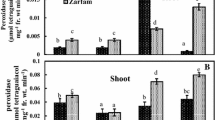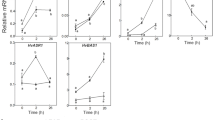Abstract
In this study, levels of MDA, total protein, soluble sugars, and enzymes activity including POX, APX, and CAT were measured in 12 dSm−1 NaCl treated seedlings belong to Licord (drought sensitive cultivar) and SLM046 (drought tolerant cultivar) of Brassica napus. The results showed that salinity increased the amount of MDA, soluble sugars and total protein in both cultivars. Two cultivars partially displayed different trend concerning enzymatic activities under salt stress experiment. Moreover, transcript abundance of four genes involved in signal transduction pathway including Auxin responsive protein, Protein kinase, MAPK3 and MAPK4 were explored at 0, 3, 6, 12 and 24 h under 12 dSm−1 NaCl treatment using RT-PCR approach. The molecular analyses of Licord cultivar revealed the lowest accumulation of all genes after 6 h exposure to NaCl except MAPK3 which was detected at the highest level at this time point. Molecular results of SLM046 cultivar showed that maximum expression of all genes occurred after 6 h treatment except MAPK3 which showed the lowest transcript at 6 h. Our studies indicate better response of SLM046 cultivar to salinity condition compared to Licord cultivar.







Similar content being viewed by others
References
Abdul Qados, A. M. S. (2011). Effect of salt stress on plant growth and metabolism of bean plant Vicia faba (L.). Journal of the Saudi Society of Agricultural Sciences, 10, 7–15.
Aebi, H. (1984). Catalase in vitro. In L. Packer (Ed.), Methods in enzymology (pp. 121–126). San Diego, CA: Academic Press Inc.
Ashraf, M., & Harris, P. J. C. (2004). Potential biochemical indicators of salinity tolerance in plants. Plant Science, 166, 3–16.
Ashraf, M., & McNeilly, T. (2004). Salinity tolerance in some Brassica oilseeds. Critical Reviews in Plant Sciences, 23, 157–174.
Azevedo Neto, A. D., Prico, J. T., Eneas-Filho, J., Braga de Abreu, C. E., & Gomes-Filho, E. (2006). Effect of salt stress on antioxidative enzymes and lipid peroxidation in leaves and roots of salt-tolerant and salt-sensitive maize genotypes. Environmental and Experimental Botany, 56, 87–94.
Borsani, O., Valpuesta, V., & Botella, M. A. (2001). Evidence for a role of salicylic acid in the oxidative damage generated by NaCl and osmotic stress in Arabidopsis seedlings. Plant Physiology, 126, 1024–1030.
Fan, Y., Shabala, S., Ma, Y., Xu, R., & Zhou, M. (2015). Using QTL mapping to investigate the relationships between abiotic stress tolerance (drought and salinity) and agronomic and physiological traits. BMC Genomics, 16, 43.
Flowers, T. J. (2004). Improving crop salt tolerance. Journal of Experimental Botany, 55, 307–319.
Gueta-Dahan, Y., Yaniv, Z., Zilinskas, B. A., & Ben-Hayyim, G. (1997). Salt and oxidative stress: Similar and specific responses and their relation to salt tolerance in citrus. Planta, 203, 460–469.
Heath, R. L., & Packer, L. (1968). Photo peroxidation in isolated chloroplasts. Archives of Biochemistry and Biophysics, 125, 850–857.
Hernandez, J. A., Jimenez, A., Mullineaux, P., & Sevilla, F. (2000). Tolerance of pea (Pisum sativum) to long term salt stress is associated with induction of antioxidant defences. Plant Cell and Environment, 23, 853–862.
Hernandez, J. A., Olmos, E., Corpas, F. J., Sevilla, F., & Del Rio, L. A. (1995). Salt induced oxidative stress in chloroplasts of pea plants. Plant Science, 105, 151–167.
Koca, H., Bor, M., Özdemir, F., & Türkan, İ. (2007). The effect of salt stress on lipid peroxidation, antioxidative enzymes and proline content of sesame cultivars. Environmental and Experimental Botany, 60, 344–351.
Kochert, G. (1978). Carbohydrate determination by phenol-sulfuric acid method. In J. A. Hellebust & J. S. Craige (Eds.), Handbook of physiological methods: physiological and biochemical methods (pp. 95–97). London: Cambridge University Press.
Lee, D. H., Kim, Y. S., & Lee, C. B. (2001). The inductive responses of the antioxidant enzymes by salt stress in the rice (Oryza sativa L.). Journal of Plant Physiology, 158, 737–745.
Liang, C., Feng, R., Hui, Z., Weimin, J., & Xuebao, L. (2010). Identification and expression analysis of genes in response to high-salinity and drought stresses in Brassica napus L. Acta Biochimica et Biophysica Sinica, 42, 154–164.
Lopez, F., Vansuyt, G., Casse-Delbart, F., & Fourcroy, P. (1996). Ascorbate peroxidase activity, not the mRNA level, is enhanced in salt-stressed Raphanus sativus plants. Physiologia Plantarum, 97, 13–20.
Lowry, O. H., Rosenbrough, N. J., Farr, A. L., & Randall, R. J. (1951). Protein measurement with the folin phenol reagent. Journal of Biological Chemistry, 193, 265–275.
MAPK Group. (2002). Mitogen-activated protein kinase cascades in plants: A new nomenclature. Trends in Plant Science, 7, 301–308.
Masood, A., Shah, N. A., Zeeshan, M., & Abraham, G. (2006). Differential response of antioxidant enzymes to salinity stress in two varieties of Azolla (Azolla pinnata and Azolla filiculoides). Environmental and Experimental Botany, 58, 216–222.
Meloni, D. A., Oliva, M. A., Martinez, C. A., & Cambraia, J. (2003). Photosynthesis and activity of superoxide dismutase peroxidase and glutathione reductase in cotton under salt stress. Environmental and Experimental Botany, 49, 69–76.
Meneguzzo, S., Navari-Izzo, F., & Izzo, R. (1999). Antioxidative responses of shoots and roots of wheat to increasing NaCl concentrations. Journal of Plant Physiology, 155, 27–280.
Misra, N., & Dwivedi, U. N. (2004). Genotypic difference in salinity tolerance of green gram cultivars. Plant Science, 166, 1135–1142.
Munns, R., & Tester, M. (2008). Mechanisms of salinity tolerance. Annual Review of Plant Biology, 59, 651–681.
Murashige, T., & Skoog, F. A. (1962). Revised medium for rapid growth and bioassays with tobacco cultures. Physiologia Plantarum, 159, 473–479.
Nakano, Y., & Asada, K. (1981). Hydrogen peroxide is scavenged by ascorbate specific peroxidase in spinach chloroplasts. Plant and Cell Physiology, 22, 867–880.
Parida, A., Das, A. B., & Das, P. (2002). NaCl stress causes changes in photosynthetic pigments, proteins and other metabolic components in the leaves of a true mangrove, Bruguiera parviflora, in hydroponic cultures. Journal of Plant Biology, 45, 28–36.
Pedley, K. F., & Martin, G. B. (2005). Role of mitogen-activated protein kinases in plant immunity. Current Opinion in Plant Biology, 8, 541–547.
Rodriguez, M. C., Petersen, M., & Mundy, J. (2010). Mitogen-activated protein kinase signaling in plants. Annual Review of Plant Biology, 61, 621–649.
Sakamoto, A., & Murata, N. (2002). The role of glycine betaine in the protection of plants from stress: Clues from transgenic plants. Plant Cell and Environment, 25, 163–171.
Shirani Rad, A. H., Naeemi, M., & Nasr Esfahani, S. H. (2010). Evaluation of terminal drought stress tolerance in spring and winter rapeseed genotypes. Iranian Journal of Crop Sciences, 12, 112–126. (in Persian).
Singh, S. K., Sharma, H. C., Goswami, A. M., Datta, S. P., & Singh, S. P. (2000). In vitro growth and leaf composition of grapevine cultivar as affected by sodium chloride. Biologia Plantarum, 43, 283–286.
Smirnoff, N. (1995). Antioxidant system and plant responses to the environment. In N. Smirnoff (Ed.), Environment and plant metabolism: Flexibility and acclimation (pp. 217–243). Oxford: Bios Scientific Publishers.
Sreenivasulu, N., Grimm, R., Wobus, U., & Weachke, W. (2000). Differential response of antioxidant compounds to salinity stress in salt tolerant and salt sensitive seedlings of foxtail millet (Setaria italica). Physiologia Plantarum, 109, 435–442.
Stone, J. M., & Walker, J. C. (1995). Plant protein kinase families and signal transduction. Plant Physiology, 108, 451–457.
Tijen, D., & Ismail, T. (2005). Comparative lipid peroxidation, antioxidant defense systems and proline content in roots of two rice cultivars differing in salt tolerance. Environmental and Experimental Botany, 53, 247–257.
Wang, Z., Mao, H., Dong, C., Ji, R., Cai, L., Fu, H., et al. (2009). Overexpression of Brassica napus MPK4 enhances resistance to Sclerotinia sclerotiorum in oilseed rape. Molecular Plant Microbe Interactions, 22, 235–244.
Xiong, L., & Yang, Y. (2003). Disease resistance and abiotic stress tolerance in rice are inversely modulated by an abscisic acid-inducible mitogen-activated protein kinase. Plant Cell, 15, 745–759.
Xiong, L., & Zhu, J. K. (2002). Molecular and genetic aspects of plant responses to osmotic stress. Plant Cell and Environment, 25, 131–139.
Yan, J. Y., Wang, J., Tissue, D., Holaday, A. S., Allen, R., & Zhang, H. (2003). Photosynthesis and seed production under water-deficit condition in transgenic tobacco plants that overexpress Arabidopsis ascorbate peroxidase gene. Crop Science, 43, 1477–1483.
Yang, Q., Chen, Z. Z., Zhou, X. F., Yin, H. B., Li, X., Xin, X. F., et al. (2009). Overexpression of SOS (salt overly sensitive) genes increase salt tolerance in transgenic Arabidopsis. Molecular Plant, 2, 22–31.
Yu, S., Zhang, L., Zuo, K., Tang, D., & Tang, K. (2005). Isolation and characterization of an oilseed rape MAP kinase BnMPK3 involved in diverse environmental stresses. Plant Science, 169, 413–421.
Zhang, X., Lu, G., Long, W., Zou, X., Li, F., & Nishio, T. (2014). Recent progress in drought and salt tolerance studies in Brassica crops. Breeding Science, 64, 60–73.
Acknowledgements
Authors are also thankful to Biotechnology Research Center of Urmia University for technical support of this work.
Author information
Authors and Affiliations
Corresponding author
Ethics declarations
Conflict of interest
The authors declare that they have no conflict of interest.
Rights and permissions
About this article
Cite this article
Rahmani, F., Peymani, A. & Hassanzadeh Gorttapeh, A. Comparison of biochemical and molecular responses of two Brassica napus L. cultivars differing in drought tolerance to salt stress. Ind J Plant Physiol. 23, 48–56 (2018). https://doi.org/10.1007/s40502-017-0323-y
Received:
Accepted:
Published:
Issue Date:
DOI: https://doi.org/10.1007/s40502-017-0323-y




